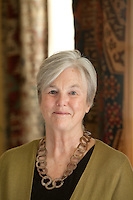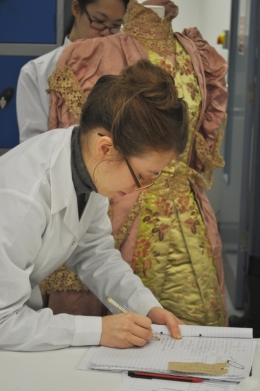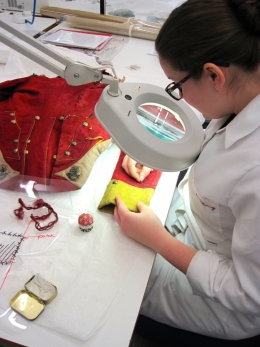The Textile Conservation Foundation
Brief Background
The TC Foundation (Registered Charity nos. 269430 and SC044036) ran the Textile Conservation Centre from 1975-1999, when the TCC was independent and based at Hampton Court Palace. The merger with the University of Southampton was negotiated by the Foundation and it also oversaw a major capital campaign to raise funds to support the move. After the merger with the University of Southampton the TCC Foundation continued to support the work of the TCC, mainly through support for fundraising.
The University of Southampton closed the TCC in 1999 and the TC Foundation secured a future for the Centre's work by agreeing with the Unviersity of Glasgow to establish a new Centre for Textile Conservation and Technical Art History, which opened in 2011.
In addition, the TC Foundation supported efforts to raise awareness to conservation and contribute to the debate about its role and importance, by commissioning research by Demos, 'It's a Material World: caring for the public realm'. The Foundation also commissioned a report reviewing conservation education in the UK, which helped to inform the development of Icon's strategy for conservation education.
The TC Foundation's current Trustees are: Clare Meredith,(Chairman), Shona Malcolm (Hon. Treasurer), Dr Mary Brooks, Ian Gow, Caroline Lorimer and Professor Nick Pearce/ Brief biographies of the Trustees are attached below. The Duke of Wellington is President of the TC Foundation and Cindy Chetwode is its Vice-President. The Trustees are assisted by Clare Daly, Company Secretary, and by Nell Hoare, who focuses mainly on fundraising.
The Centre for Textile Conservation and Technical Art History, University of Glasgow
The Trustees of The Textile Conservation Centre Foundation worked tirelessly to ensure that the work of the TCC was not lost forever as a result of the University of Southampton's decision to close the Centre in October 2009.
The new Centre for Textile Conservation and Technical Art History opened in Glasgow September 2010. The Foundation made the assets of the TCC freely available to Glasgow University, these include equipment, the TCC Library and intellectual property. On the Foundation's behalf Nell Hoare (formerly Director of the TCC) undertook a fundraising campaign to raise funds to cover the development costs of the new centre in Glasgow. A total of over £475,000 was raised from external sources: funders were incredibly supportive as they were as keen as the TC Foundation to ensure that the TCC's internationally significant work could continue.
The new Centre for Textile Conservation and Technical Art History was formally opened by HRH The Princess Royal in February 2011. The Centre's staff are led by Frances Lennard, Senior Lecturer in Textile Conservation.
The move to Glasgow has proved to be a huge success, with the Centre going from strength to strength. The successor programme, the 2-year MPhil Textile Conservation, is as highly regarded internationally as its predecessor. Since the Centre opened in Glasgow, four cohorts of students have graduated and all are now working in conservation around the world. You can find out more about the work of the staff of the Centre by following the Centre's blog.
In 2016 Frances Lennard and colleagues successfully secured three major research grants to a total value of over £1.3m, as follows:
Situating Pacific Barkcloth Production in Time and Place
This major, three-year project is funded by AHRC and led by Frances Lennard; the project partners are the Hunterian Museum, the Kew Economic Botany Collection and the Smithsonian Insititution. To find out more follow this link.
From the Golden Age to the Digital Age: modelling and monitoring historic tapestries
This three-year project, funded by the Leverhulme Trust, led by Frances Lennard, will carry out research into tapestry conservation and display. You can find out more by following this link.
Competition for research funding is fierce, so the success of the Centre in securing three major research grants in the space of 8 months is extraordinary. It is good evidence of the success of the move to Glasgow University.



